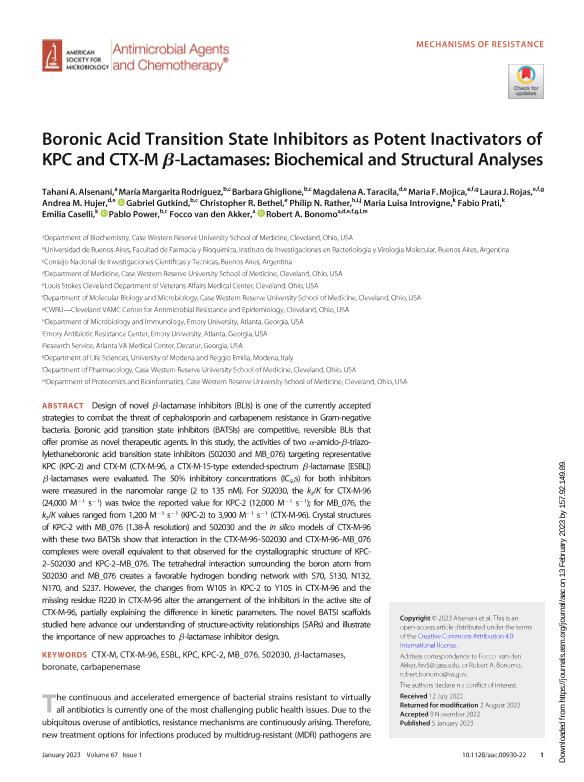Artículo
Boronic Acid Transition State Inhibitors as Potent Inactivators of KPC and CTX-M β-Lactamases: Biochemical and Structural Analyses
Alsenani, Tahani A.; Rodríguez, María Margarita ; Ghiglione, Barbara
; Ghiglione, Barbara ; Taracila, Magdalena A.; Mojica, Maria F.; Rojas, Laura J.; Hujer, Andrea M.; Gutkind, Gabriel Osvaldo
; Taracila, Magdalena A.; Mojica, Maria F.; Rojas, Laura J.; Hujer, Andrea M.; Gutkind, Gabriel Osvaldo ; Bethel, Christopher R.; Rather, Philip N.; Introvigne, Maria Luisa; Prati, Fabio; Caselli, Emilia; Power, Pablo
; Bethel, Christopher R.; Rather, Philip N.; Introvigne, Maria Luisa; Prati, Fabio; Caselli, Emilia; Power, Pablo ; van den Akker, Focco; Bonomo, Robert A.
; van den Akker, Focco; Bonomo, Robert A.
 ; Ghiglione, Barbara
; Ghiglione, Barbara ; Taracila, Magdalena A.; Mojica, Maria F.; Rojas, Laura J.; Hujer, Andrea M.; Gutkind, Gabriel Osvaldo
; Taracila, Magdalena A.; Mojica, Maria F.; Rojas, Laura J.; Hujer, Andrea M.; Gutkind, Gabriel Osvaldo ; Bethel, Christopher R.; Rather, Philip N.; Introvigne, Maria Luisa; Prati, Fabio; Caselli, Emilia; Power, Pablo
; Bethel, Christopher R.; Rather, Philip N.; Introvigne, Maria Luisa; Prati, Fabio; Caselli, Emilia; Power, Pablo ; van den Akker, Focco; Bonomo, Robert A.
; van den Akker, Focco; Bonomo, Robert A.
Fecha de publicación:
01/2023
Editorial:
American Society for Microbiology
Revista:
Antimicrobial Agents and Chemotherapy
ISSN:
0066-4804
Idioma:
Inglés
Tipo de recurso:
Artículo publicado
Clasificación temática:
Resumen
Design of novel β-lactamase inhibitors (BLIs) is one of the currently accepted strategies to combat the threat of cephalosporin and carbapenem resistance in Gram-negative bacteria. Boronic acid transition state inhibitors (BATSIs) are competitive, reversible BLIs that offer promise as novel therapeutic agents. In this study, the activities of two α-amido-β-triazolylethaneboronic acid transition state inhibitors (S02030 and MB_076) targeting representative KPC (KPC-2) and CTX-M (CTX-M-96, a CTX-M-15-type extended-spectrum β-lactamase [ESBL]) β-lactamases were evaluated. The 50% inhibitory concentrations (IC50s) for both inhibitors were measured in the nanomolar range (2 to 135 nM). For S02030, the k2/K for CTX-M-96 (24,000 M21 s21) was twice the reported value for KPC-2 (12,000 M21 s21); for MB_076, the k2/K values ranged from 1,200 M21 s21 (KPC-2) to 3,900 M21 s21 (CTX-M-96). Crystal structures of KPC-2 with MB_076 (1.38-Å resolution) and S02030 and the in silico models of CTX-M-96 with these two BATSIs show that interaction in the CTX-M-96–S02030 and CTX-M-96–MB_076 complexes were overall equivalent to that observed for the crystallographic structure of KPC-2–S02030 and KPC-2–MB_076. The tetrahedral interaction surrounding the boron atom from S02030 and MB_076 creates a favorable hydrogen bonding network with S70, S130, N132, N170, and S237. However, the changes from W105 in KPC-2 to Y105 in CTX-M-96 and the missing residue R220 in CTX-M-96 alter the arrangement of the inhibitors in the active site of CTX-M-96, partially explaining the difference in kinetic parameters. The novel BATSI scaffolds studied here advance our understanding of structure-activity relationships (SARs) and illustrate the importance of new approaches to β-lactamase inhibitor design.
Palabras clave:
BORONATE
,
CARBAPENEMASE
,
CTX-M
,
CTX-M-96
,
ESBL
,
KPC
,
KPC-2
,
MB_076
,
S02030
,
Β-LACTAMASES
Archivos asociados
Licencia
Identificadores
Colecciones
Articulos(OCA HOUSSAY)
Articulos de OFICINA DE COORDINACION ADMINISTRATIVA HOUSSAY
Articulos de OFICINA DE COORDINACION ADMINISTRATIVA HOUSSAY
Citación
Alsenani, Tahani A.; Rodríguez, María Margarita; Ghiglione, Barbara; Taracila, Magdalena A.; Mojica, Maria F.; et al.; Boronic Acid Transition State Inhibitors as Potent Inactivators of KPC and CTX-M β-Lactamases: Biochemical and Structural Analyses; American Society for Microbiology; Antimicrobial Agents and Chemotherapy; 67; 1; 1-2023; 1-10
Compartir
Altmétricas



